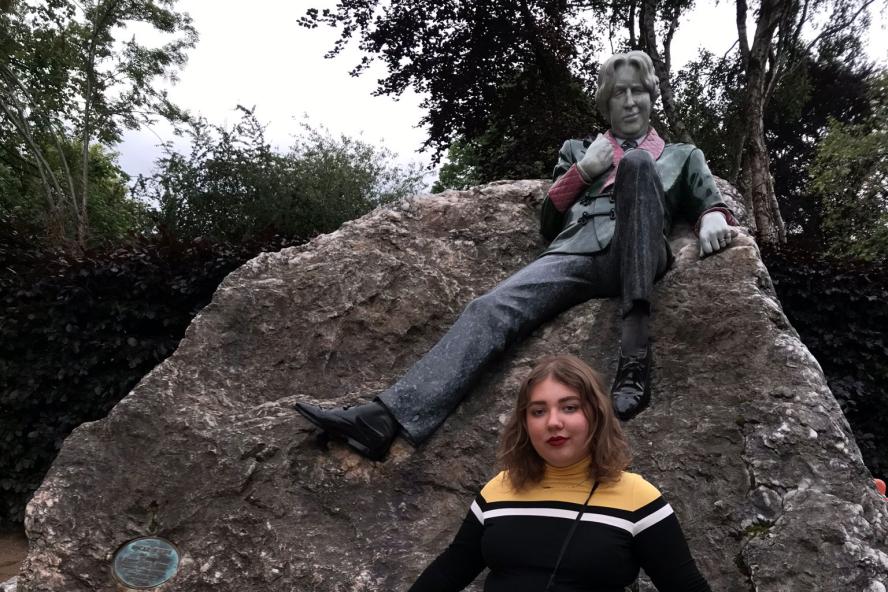Instructor Spotlight: Tamar Bresge

Tell us about your background and what inspired you to teach this course?
Tamar Bresge: I am in a peculiar position as an artist; I have a disability that causes progressive vision and hearing loss. I am not blind, but I am not fully sighted. I am not deaf, but I am not fully hearing. It is through the language of having to describe my body, which occupies the space of the in-between, that I have been called to the problem of language.
I am an artist who works between media. I have spent most of my professional life torn between calling myself “a writer who makes art” or “an artist who writes,” trying to know if these mean the same thing. I am focused on deconstructing the perceived boundaries between art and writing practices, instead exploring the movement between these words as a cyclical, redoubling space. The major assignment for my course is for students to unknot the borders around words that separate, taxonomize, and create differences. Instead, we are looking for sameness, for spaces over likeness, overlap, and traces in the subjects of art and writing. Our overarching assignment is to inhabit and tend to the space of the in-between.
Could you give us some examples of your favorite art pieces, or writing pieces, that you think encapsulate both mediums?
TB: Yes! Jenny Holzer is a language-based artist who often inserts short, aphoristic text into spaces — or onto objects. One of my favorite of her pieces is a looming electric sign over Times Square with the text, PROTECT ME FROM WHAT I WANT. In a different direction is Anne Carson’s If Not, Winter: Fragments of Sappho. Carson translates Sappho’s poetry not only through language, but through the visual construction of the page. She uses punctuation to create space where fragments of the original text are lost to time, visually signifying absence through marks, rather than words. The space of the written page is often overlooked in its visual impact, and Carson is a writer who is keenly attentive to it, the pages of her books often resembling drawings of sorts.
Could you tell us a bit about your final project and give us a sneak peek into what your students are planning?
TB: Because this course aspires to let each student hone their own unique relationship to art, writing, and the space between, the major final project is open in medium. I want each student to be able to explore ideas and materials boldly, in a production that best suits their experience of the classroom and the trajectory of their education. This highly motivated group did not disappoint — every student has come up with a personally crafted major project outline! We have a student building an interactive, sprawling website to explore languages of coding, image, and sporadic pathways. Another student is handwriting and illustrating a piece of imagined folklore/fable. We even have a student writing a sort of socio-anthropological field guide of the different behaviors observed in collections of Tufts students based on location. Other students are engaging with performance, sound art, painting, photography, and poetry, and more.
What is something you are looking forward to in your course later in the semester?
TB: I had been eagerly anticipating our class trip to Tufts University Art Galleries, which we just did this past week, having the opportunity to put thought into action as a group. Our course readings cover a wide range of material across literary and critical theory, sociology, psychology, phenomenology and on... This occupies a lot of head space in the classroom, sometimes very sinuous and capillary in nature. Taking these ideas into the gallery — putting them into active practice as a group — was incredibly rewarding! Looking ahead, I’m excited for our creative writing workshop in blackout poetry in a few weeks’ time, looking at artist books in collaboration with the SMFA library.
What do you hope that students will take away from your class?
TB: The essential questions of our class have vital implications in social binaries inside and outside of the classroom, and I hope that my students will leave this course feeling well-versed in the world of deconstructing spaces of separateness and differences, to instead look for spaces of sameness. Of course, I hope that they will have developed practices as writers with a toolkit of visual approaches to text, image, and language. Above all, I hope to have inspired an approach to education as a sprawling, lifelong practice — for my students to leave this class not looking for answers, but looking to ask better questions.
Tamar Bresge is an artist and writer working at the intersection of text, literature, language, and image. She is an MFA candidate at the School of the Museum of Fine Arts at Tufts.